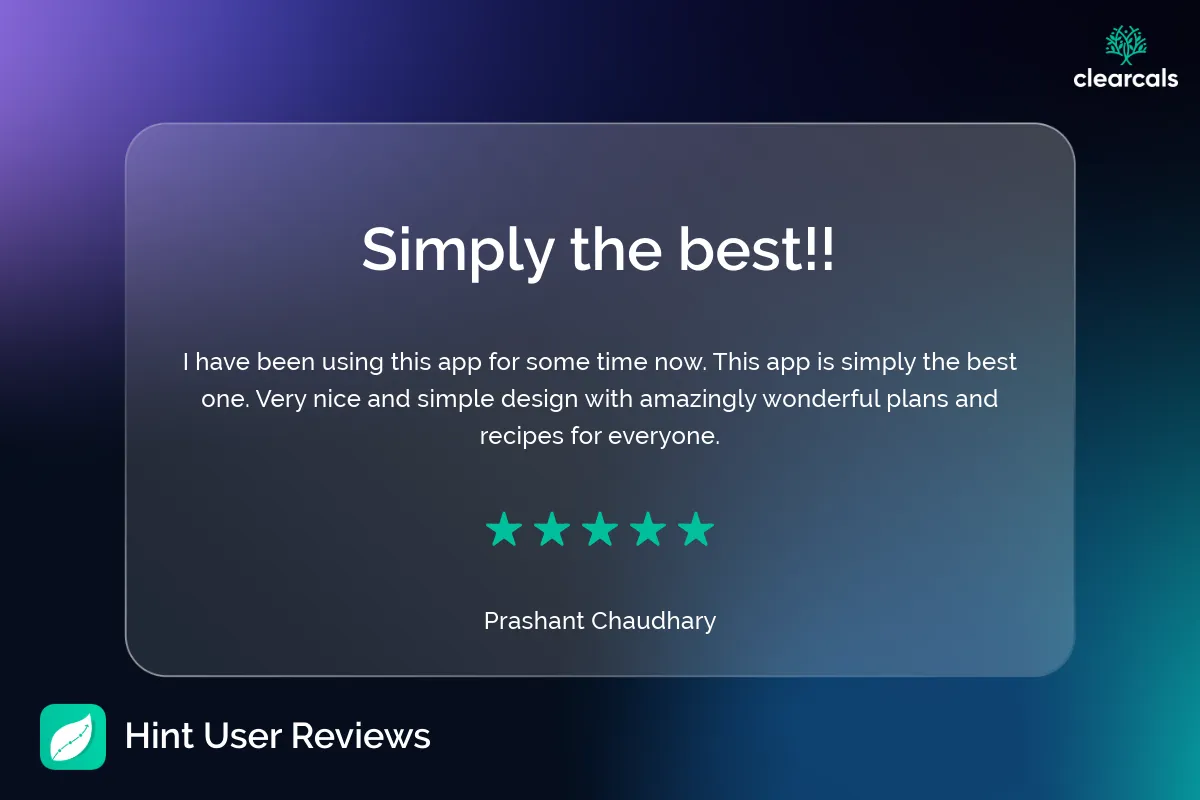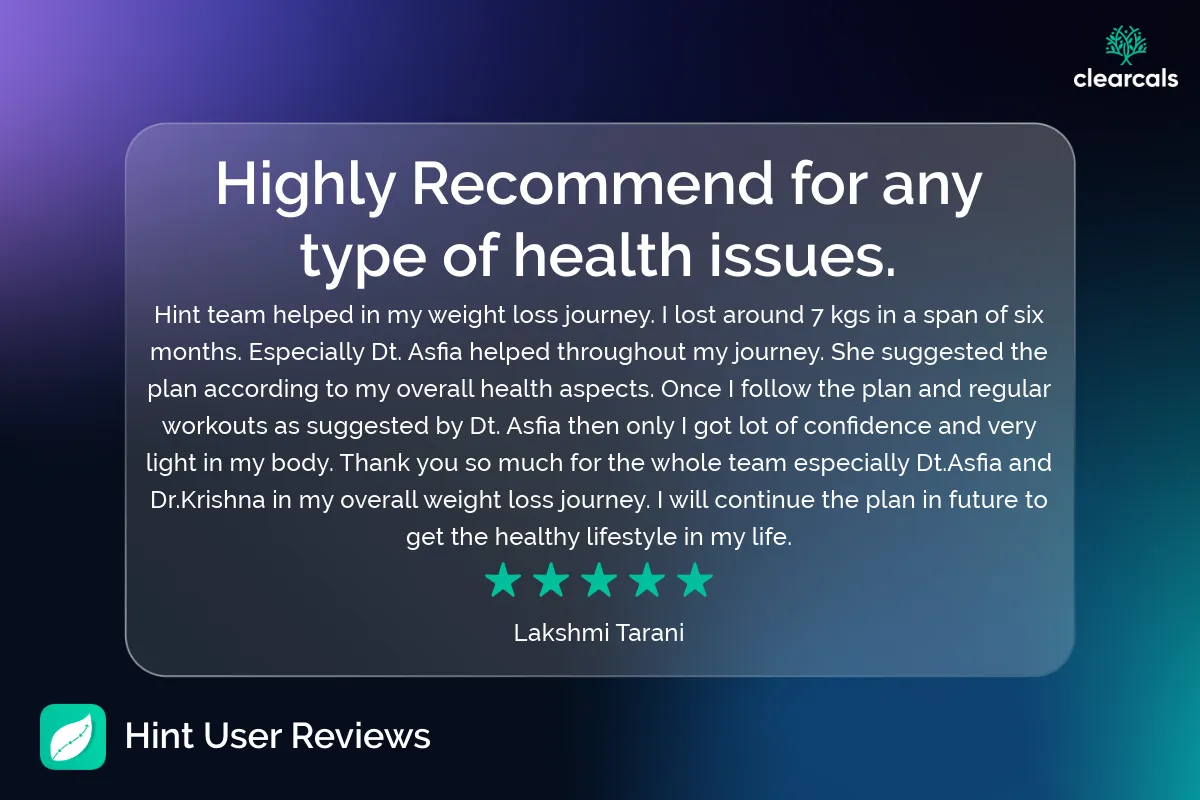Looking for a Personalized Diet Plan?
Dyslipidemia Diet (Triglycerides Diet and Cholesterol Diet Chart)

TLDR
- You can now get a personalized Dyslipidemia Diet Plan in minutes using the Hint app.
- This plan is designed to help you manage your cholesterol and triglyceride levels effectively while optimizing your overall health.
- Discover the do’s, don’ts, and diet tips to get the best results from the Hint Dyslipidemia Diet Plan.
- For any further questions, please contact us at support@clearcals.com or explore the FAQs at the end.
How to Subscribe to Hint Pro or Hint Premium for Your Dyslipidemia Diet Plan:
Download and Install the Hint App:
Search for "Hint" in the Apple App Store or Google Play Store. Download and install the app on your device.
Create an Account or Log In:
Open the app and either create an account or log in with your existing credentials.
You’ll need to provide your profile details, including age, gender, height, weight, and physical activity level, to personalize your Dyslipidemia Diet Plan.
Choose a Subscription Plan:
Select "Subscribe to Hint Pro" and choose a plan (monthly, quarterly, or yearly). With Hint Pro, you’ll get instant access to your personalized Dyslipidemia Diet Plan, tailored to your specific health and nutrition goals.
Opt for Hint Premium for enhanced support, including unlimited consultations with expert dietitians to help you optimize your heart health and manage cholesterol and triglyceride levels effectively.
Enter Payment Information and Confirm:
Complete the subscription process and instantly access your personalized Dyslipidemia Diet Plan, along with the advanced features of Hint Pro or Hint Premium to support your journey toward improved heart health and balanced cholesterol levels.

Overview
Dyslipidemia refers to abnormal levels of fats (lipids) in the blood, including cholesterol and triglycerides. Typically, this means elevated LDL cholesterol ("bad" cholesterol) and/or triglycerides and low HDL cholesterol ("good" cholesterol).
If left unmanaged, dyslipidemia can increase the risk of heart disease, stroke, and other cardiovascular conditions.
Fortunately, lifestyle modifications—particularly through diet—can significantly help manage dyslipidemia. Adopting a dyslipidemia diet that is low in saturated fats and high in fiber, combined with regular exercise, can make a huge difference in lowering cholesterol and triglycerides.
The Hint Dyslipidemia Diet Plan is crafted to help you make these positive lifestyle changes.
This diet focuses on whole grains, fresh fruits, vegetables, lean proteins, and healthy fats while cutting out processed foods and added sugars.
Here’s why the Hint Dyslipidemia Diet Plan is beneficial:
Key Benefits of the Hint Dyslipidemia Diet Plan:
1. Lowers Cholesterol and Triglycerides
Managing dyslipidemia effectively starts with improving dietary habits. The Hint Dyslipidemia Diet emphasizes heart-healthy foods such as oats, legumes, fruits, vegetables, and whole grains that are high in fiber.
These foods help reduce LDL cholesterol and triglycerides while boosting HDL cholesterol.
The plan also promotes the inclusion of healthy fats from nuts, seeds, and olive oil, while limiting saturated fats found in processed foods and certain animal products.
2. Reduces Risk of Heart Disease and Stroke
Lowering cholesterol and triglyceride levels is key to preventing cardiovascular events such as heart attacks and strokes.
The Hint Dyslipidemia Diet Plan helps manage these lipid levels effectively, thus reducing the risk of heart disease and stroke.
Following this plan, paired with exercise, can lead to significant improvements in heart health.
3. Promotes Healthy Weight Loss
Weight management plays a vital role in reducing cholesterol and triglyceride levels. Excess weight, especially around the abdomen, is closely linked to high LDL cholesterol and triglycerides.
The Hint Dyslipidemia Diet Plan is calorie-controlled and balanced, offering nutritious food options to help achieve weight loss while supporting lipid control.
The plan encourages high-fiber foods, lean proteins, and healthy fats, making it easier to maintain a calorie deficit for sustainable weight loss.
4. Improves Blood Sugar Levels
Dyslipidemia is often associated with insulin resistance and metabolic abnormalities, which can also affect blood sugar levels.
The Hint Dyslipidemia Diet Plan includes nutrient-rich foods that stabilize blood sugar and improve insulin sensitivity, helping to reduce the risk of developing type 2 diabetes.
This holistic approach supports overall metabolic health.
5. 6-Day Workout Plan
The Hint Dyslipidemia Diet Plan comes with a safe, effective 6-day workout plan designed for all fitness levels.
This workout plan includes aerobic exercises like walking, jogging, and cycling, along with strength training exercises.
By incorporating physical activity into your routine, you can further improve cholesterol levels and promote heart health.
6. Instant Calorie Tracking
The Hint app offers an instant calorie tracking feature that helps you monitor your meals and calorie intake.
This feature is particularly useful for those aiming to lose weight while keeping an eye on cholesterol and triglyceride levels.
Tracking your progress ensures you stay within your daily goals and maintain balance in your dyslipidemia diet.
Plan Type
This is a monthly subscription plan, available for renewal every month, every three months, or annually, based on your preference.
Diet Types Available
The Hint Dyslipidemia Diet Plan is available in three different versions to accommodate your dietary preferences:
Dyslipidemia Indian Vegetarian Diet Plan
This plan focuses on plant-based foods and dairy products, excluding eggs, meat, fish, and other animal products.
Dyslipidemia Ovo-Vegetarian Diet Plan
This plan includes vegetarian foods and various egg recipes but does not include meat, fish, or seafood.
Dyslipidemia Non-Vegetarian Diet Plan
This plan includes a combination of vegetarian foods, eggs, dairy, meat, fish, and seafood, offering more flexibility in meal options.

Do's & Don'ts:
Do’s:
- Start your day with half a teaspoon of fenugreek seed powder to lower cholesterol levels.
- Consume plenty of fiber-rich fruits and vegetables to support heart health.
- Opt for lean proteins like dals, legumes, fish, poultry, and egg whites.
- Choose whole grains such as brown rice, oats, and quinoa over refined grains.
- Incorporate healthy fats like almonds, walnuts, flaxseeds, and sesame seeds into your diet.
- Use heart-healthy oils like olive oil or avocado in moderation.
- Drink plenty of water and stay hydrated.
- Exercise regularly to improve your HDL cholesterol and maintain a healthy weight.
Don’ts:
- Avoid foods high in saturated fats and trans fats (fried foods, fatty meats, processed foods).
- Don’t consume excessive amounts of sugar and refined carbohydrates, which can raise triglyceride levels.
- Limit alcohol intake, as it can elevate triglyceride levels.
- Avoid skipping meals or overeating, as this can lead to weight gain and worsen lipid levels.
- Steer clear of salty and processed foods, as they raise blood pressure and cholesterol.
Tips for Success on the Dyslipidemia Diet:
- Increase fiber intake with whole grains, fruits, vegetables, and legumes to help lower cholesterol levels.
- Choose healthy fats like MUFA (monounsaturated fats) and PUFA (polyunsaturated fats) found in nuts, seeds, and olive oil to improve cholesterol levels.
- Avoid processed foods high in unhealthy fats, sugars, and sodium.
- Exercise regularly and aim for at least 30 minutes of physical activity each day to boost HDL cholesterol and maintain a healthy weight.
- Get regular lipid profile tests to monitor cholesterol and triglyceride levels.
- Use the Hint app to track your calorie intake and stay within your health goals.
Frequently Asked Questions (FAQs)
1. What is dyslipidemia?
Dyslipidemia is a condition where there are abnormal levels of lipids (fats) in the blood, including high LDL cholesterol, low HDL cholesterol, and/or elevated triglycerides.
2. What causes dyslipidemia?
It can result from genetics, lifestyle factors such as poor diet and lack of exercise, and other health conditions like diabetes or hypothyroidism.
3. How is dyslipidemia treated?
Dyslipidemia can be managed with lifestyle changes such as following a dyslipidemia diet and exercising regularly. In some cases, medication is also required.
4. What foods should I avoid if I have dyslipidemia?
Avoid foods high in saturated fats, trans fats, and added sugars such as fried foods, fatty meats, and processed snacks.
5. What are the best foods for a dyslipidemia diet?
Eat plenty of fruits, vegetables, whole grains, lean proteins, and healthy fats from sources like nuts and olive oil.
6. Can dyslipidemia be reversed?
While dyslipidemia is a chronic condition, it can be effectively managed and improved with the right lifestyle changes and, in some cases, medication.
7. Does ghee increase triglycerides?
Yes, ghee is high in saturated fat, which can increase triglycerides and cholesterol.
8. How can I increase HDL cholesterol?
Increase your intake of healthy fats, exercise regularly, and focus on eating fiber-rich foods like fruits, vegetables, and whole grains.
Final Thoughts
The Hint Dyslipidemia Diet Plan offers a comprehensive approach to managing cholesterol and triglyceride levels while promoting overall heart health.
With personalized meal plans based on Indian recipes, calorie tracking, and a 6-day workout plan, this dyslipidemia diet provides everything you need to take control of your lipid profile.
Download the Hint app today and embark on a healthier, heart-smart lifestyle!





